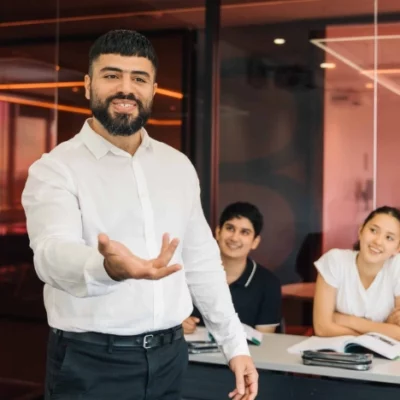Welcome to Matrix Education
To ensure we are showing you the most relevant content, please select your location below.
Select a year to see courses
Learn online or on-campus during the term or school holidays
Learn online or on-campus during the term or school holidays
Learn online or on-campus during the term or school holidays
Learn online or on-campus during the term or school holidays
Learn online or on-campus during the term or school holidays
Learn online or on-campus during the term or school holidays
Learn online or on-campus during the term or school holidays
Get HSC Trial exam ready in just a week
Get HSC exam ready in just a week
Select a year to see available courses
Science guides to help you get ahead
Science guides to help you get ahead

The Beginner’s Guide to Physics Practical Skills is a comprehensive resource that will equip you with essential scientific skills required for conducting first and second-hand investigations.
Your knowledge and understanding of these Physics skills are pivotal to success in your Physics practical assessments at school as 60% weighting is allocated on the skills component of your school assessments.
60% weighting is allocated on the skills component of assessments
In this Guide we discuss:
Try Matrix for free!
Experience the Matrix advantage for yourself, risk-free. Book a free trial today and join a class!
Scientific investigations have several stages:
An outline of the scientific method is shown in the flowchart below. Scientific investigations (e.g experiments) form a crucial part of the scientific method.
Practical skills are required in order to carry out each stage of an investigation.
These practical skills are assessed under the Working Scientifically Skills section of the Stage 6 (Year 11 and 12) Physics syllabus.
The stated objective of the syllabus is that students must “develop skills in applying the process of working scientifically.”
We’ve tabulated the Physics skills outcomes for different stages of scientific investigations that you are expected to develop through the Physics course :
| Table: Skills required for Physics course (Source: NESA) | ||
| Reference | Outcome | Description |
| PH11/12-1 | Questioning and predicting | Develops and evaluates questions and hypotheses for scientific investigation |
| PH11/12-2 | Planning investigations | Designs and evaluates investigations in order to obtain primary and secondary data and information |
| PH11/12-3 | Conducting investigations | Conducts investigations to collect valid and reliable primary and secondary data and information |
| PH11/12-4 | Processing data and information | Selects and processes appropriate qualitative and quantitative data and information using a range of appropriate media |
| PH11/12-5 | Analysing data and information | Analyses and evaluates primary and secondary data and information |
| PH11/12-6 | Problem solving | Solves scientific problems using primary and secondary data, critical thinking skills and scientific processes |
| PH11/12-7 | Communicating | Communicates scientific understanding using suitable language and terminology for a specific audience or purpose |
Your in-depth knowledge and understanding of these skills are pivotal to success in physics practical assessments at school.
NESA provides the following expanded descriptions of the outcomes on their website. Let’s see what skills they expect you, as a physics student, to develop:
Questioning and predicting (PH11/12-1)
Planning investigations (PH11/12-2)
Conducting investigations (PH11/12-3)
Processing data and information (PH11/12-4)
Analysing data and information (PH11/12-5)
Problem solving (PH11/12-6)
Communicating (PH11/12-7)
Now you know what skills will be assessed, you need to understand how they will be assessed. Let’s take a look at what Physics practical assessments at school involve.
Let’s take a look at what a Physic assessment task notification looks like.
A sample Assessment Task for Year 11 Physics from NESA is shown below.
A sample Assessment Tasks for Year 12 Physics from NESA is shown below.
Your assessment task for Physics will assess your depth of knowledge, understanding and skills.
Your Physics skills will be assessed using two types of practical assessments:
Practical investigations or first-hand investigations are an essential part of both Year 11 and Year 12 course and must occupy a minimum of 35 hours of course time in each year.
Practical investigations or first-hand investigations include:
Secondary-sourced or second-hand investigations include:
Through these Physics assessment tasks, your school will determine your level of physics skills competencies.
The components and weightings for Year 11 and 12 school assessments are shown below:
| Component | Weighting % |
| Skills in working scientifically | 60 |
| Knowledge and understanding of course content | 40 |
| 100 |
As the components and weighting are mandatory for schools, your competencies in physics practical skills will play a significant role in your overall school assessment marks.
Your Physics assessment task will involve both first and second-hand investigations in which you will be required to
To calculate the unknown value, you will need to able to:
To analyse the results of an experiment, you will need to be able to:
Ask the following questions as a checklist to assess your essential scientific skills:
If you have answered no to any one of the questions, you may not be ready for your upcoming physics practical assessment.
Read Part 1 of this Guide, “How to Study for Physics Practical Exams” to learn more about preparing for your upcoming Physics assessment task.

Expert teachers, detailed feedback and one-to-one help. Book your free trial today and join a class!

"*" indicates required fields
© Matrix Education and www.matrix.edu.au, 2025. Unauthorised use and/or duplication of this material without express and written permission from this site’s author and/or owner is strictly prohibited. Excerpts and links may be used, provided that full and clear credit is given to Matrix Education and www.matrix.edu.au with appropriate and specific direction to the original content.